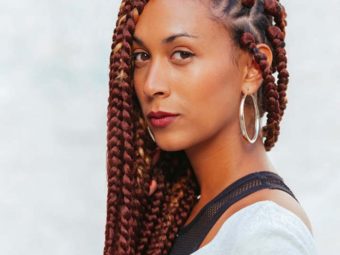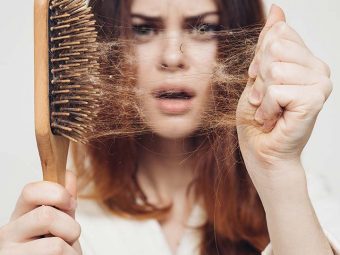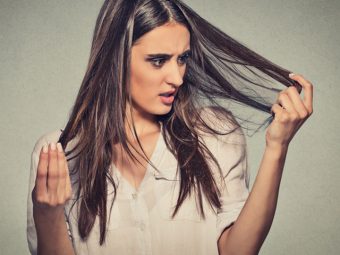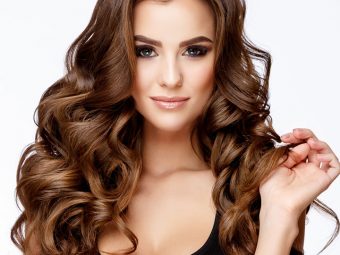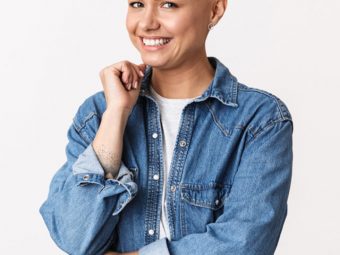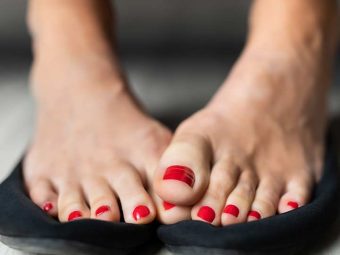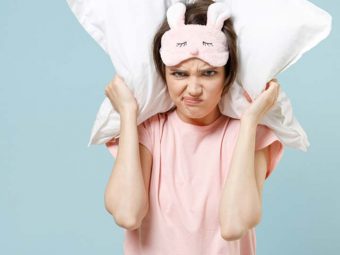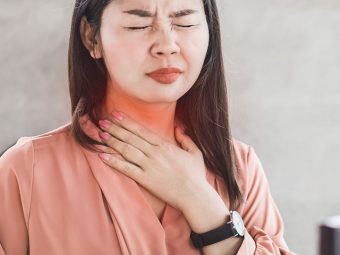10 Home Remedies To Regrow Hair On Bald Patches
Manage hair loss and prevent bald patches with these easily available remedies and ingredients.
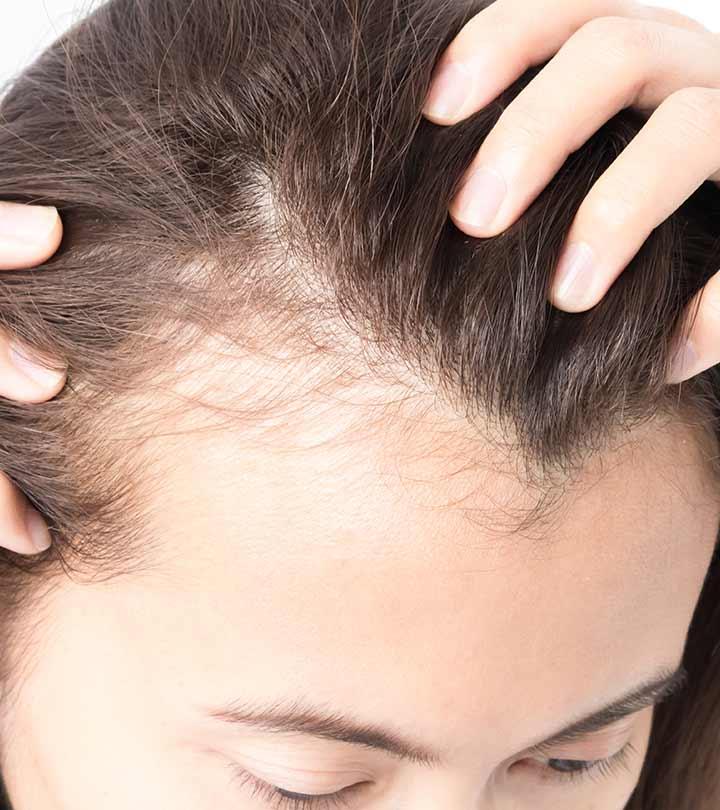
Image: shutterstock
Baldness is characterized by excessive hair loss from the scalp that develops due to disruptions in the hair development cycle. While it is more frequent in men, a tiny percentage of women also suffer from this unpleasant hair problem. The good news is that there are several natural ways to regrow hair on bald patches.
Baldness used to be linked with old age, but it now affects even young people. Baldness has become all-pervasive as a result of poor lifestyle choices, such as a lack of sufficient nourishment and stress.
We’ve put up a list of a few easy scientifically proven home remedies that have been shown to increase hair growth. If none of these methods work, talk to your doctor to figure out what’s causing your hair loss and what treatment options are available.
Learn more about the causes, kinds, and home remedies for baldness in men and women by reading on.
In This Article
What Are The Causes Of Baldness?
When it comes to male pattern baldness or female pattern baldness, genetics and hormones play a major role (1), (2). A combination of the following causes is responsible for baldness and hair loss in general:
- Aging
- Hormonal imbalance
- Injury or burns
- Scalp infections like ringworm
- Iron deficiency
- Insufficient protein content in the diet
- Family history of baldness
- Medical conditions or illnesses that cause hair loss
- Medicines used in chemotherapy (3)
- Stress and other wrong lifestyle factors
Depending on the causes and the age and gender of the person, baldness is categorized into different types.
Types Of Baldness
- Male Pattern Baldness – The condition is seen in men and can begin with a bald spot or a receding hairline. It can be either hereditary or related to the male hormone, like dihydrotestosterone.
- Female Pattern Baldness – This is seen in women and also could be hormonal, hereditary, or associated with a nutritional deficiency. It seldom results in complete baldness, though there can be diffuse thinning of hair that leads to extensive loss of hair volume and a visible scalp.
- Alopecia areata – Hair loss occurs, which leads to bald spots. This can also progress to alopecia totalis if the entire hair on the scalp is lost. According to a population-based cohort study of 4.16 million adults and children in the UK, 6765 people developed a new onset alopecia areata over the 10-year study period. It peaked at age 25–29 years for both sexes. The overall incidence rate was 0·26 per 1000 person-years.
- Scarring Alopecia – If the bald spots develop due to injury, burns, radiation, or diseases (like skin infections), the condition is called scarring alopecia. This condition needs early diagnosis of the underlying causes and must be treated by a dermatologist.
- Toxic Alopecia – This condition is usually temporary and occurs after severe illnesses or high fevers or with the intake of certain medications.
These were the different types of baldness. Identify your symptoms and use the remedies listed below to deal with excessive hair loss and bald spots.
Home Remedies To Regrow Hair On Bald Patches
- Best Oils For Baldness
- Apple Cider Vinegar
- Aloe Vera
- Onion Juice
- Ginger
- Methi
- Chinese Herbs
- Coffee
- Egg Yolk
- Licorice Root
1. Best Oils For Baldness
(a) Castor Oil
Massaging frequently with warm castor oil 20 minutes before bath stimulates the roots of the hair by increasing the circulation of blood throughout the scalp. Castor oil has anti-inflammatory and antifungal properties that can help reduce dandruff and hair loss (4), (5).
You Will Need
2-3 tablespoons of castor oil
What You Have To Do
- Lightly warm up the oil and apply it to your scalp.
- Apply 20 minutes before bath.
How Often You Should Do This
Repeat this 3-4 times a week.
(b) Coconut Oil
Coconut oil contains nourishing fats and alpha-tocopherol that keep the scalp rejuvenated and hydrated (6). This, in turn, helps to strengthen the hair follicles and stimulate hair growth. Coconut oil is also rich in antioxidants that protect the scalp and the hair fibers from damage(7). Massaging with warm coconut oil may also increase blood circulation to the hair and stimulate hair growth.
You Will Need
2-3 tablespoons of virgin coconut oil
What You Have To Do
- Warm up the oil for a couple of seconds and gently massage the scalp with it.
- Rinse off the oil after 4-5 hours. You can also keep it on overnight.
How Often You Should Do This
Do this 2-3 times a week.
(c) Peppermint Oil
This antiallergenic essential oil possesses anti-inflammatory, antioxidant, and antibacterial properties. It was shown in a study conducted in 2014 that peppermint oil-induced the growth of long hair and has hair thickening properties (8).
You Will Need
- 3-5 drops of peppermint oil
- A cup of water
- Warm towel or shower cap
What You Have To Do
- Dilute the essential oil in water and apply it to your scalp and hair.
- Cover your head with a warm towel or a shower cap for 20-30 minutes.
- Wash it off with a mild shampoo.
How Often You Should Do This
Repeat this 2 times a week.
 Quick Tip
Quick Tip(d) Pumpkin Seed Oil
The pumpkin seed oil has been tested and proved to work as a male pattern baldness treatment or androgenetic alopecia (AGA). It is rich in carotenesi XA red or orange plant pigment that gives the fruit its color. This gets converted in the body as Vitamin A to improve scalp health. ,tocopherolsi XA class of fat-soluble, organic chemical compounds with antioxidant properties which collectively constitute Vitamin E. , and other beneficial nutrients that play an important role in reversing alopecia. However, the exact mechanism of action is still not understood (9).
You Will Need
- 1 teaspoon of pumpkin seed oil
- 1 tablespoon olive oil
What You Have To Do
- Mix the oils and apply the blend onto the scalp.
- Leave it on overnight.
How Often You Should Do This
Apply this oil mixture 2 times a week.
(e) Camphor And Coconut Hair Oil
Studies have found that the application of camphor can help improve blood circulation (10). This property can help increase blood circulation in the scalp, promoting hair growth. Other studies suggest that it can aid hair growth and decrease dandruff when used in combination with coconut oil (11).
You Will Need
- 100 mL virgin of coconut oil
- 4-5 camphor tablets
What You Have To Do
- Crush the camphor tablets and mix them with coconut oil. Store this in an airtight container.
- Apply this oil to the scalp before going to bed.
How Often You Should Do This
Repeat this every night or every alternate night.
(f) Taramira Oil
Taramira oil is extracted from the seeds of arugula. It is popularly known as Jamba oil in Hindi. It contains plenty of fatty acids and has anti-inflammatory and antifungal properties and can help treat hair loss (12).
You Will Need
2-3 tablespoons of taramira oil
What You Have To Do
- Massage the scalp with this oil.
- Leave it on for 2-3 hours and then wash your scalp (and hair) as usual.
How Often You Should Do This
Do this 2 times a week.
(g) Olive Oil
Oleuropein, a phenolic compound found in olive oil, promoted hair growth in animal studies (13). It also contains squalene that acts as a moisturizer (14). Thus, olive oil can help nourish your hair and promote hair growth.
You Will Need
Virgin olive oil
What You Have To Do
- Heat the oil for a few seconds and apply it onto the scalp.
- Massage the scalp for 4-5 minutes.
- Rinse your hair in the morning. If you are running short of time, leave the oil on for at least an hour.
How Often You Should Do This
Repeat this 3 times a week.
(h) Jojoba Oil
Jojoba oil closely resembles the naturally produced oil by the skin and is easily absorbed. It has anti-inflammatory and moisturizing effects (15). These effects can help in nourishing your hair and promoting hair growth.
You Will Need
A few teaspoons of jojoba oil
What You Have To Do
- Massage the oil directly onto the scalp for a few minutes.
- Leave it on for 3-4 hours before rinsing it off.
How Often You Should Do This
Do this 2-3 times a week.
(i) Tea Tree Oil
Extreme dandruff and infections of the scalp can sometimes lead to bald spots (16). In such cases, tea tree oil works well as it is a wide-spectrum antimicrobial agent. A study showed that 5% tea tree oil was effective in the treatment of dandruff (17).
You Will Need
- 3-4 drops of tea tree oil
- 2 tablespoons of carrier oil (olive, coconut or almond)
What You Have To Do
- Dilute the essential oil by mixing it with the carrier oil of your choice.
- Apply this blend to the scalp and let it sit for at least an hour.
- Rinse using a mild shampoo.
How Often You Should Do This
Apply this oil blend 2 times a week.
(j) Kalonji Oil
Kalonji oil is also known as black seed oil and is often prescribed in Unani medicine as a bald spot and hair loss solution (18). It strengthens the hair follicles and regenerates them, leading to fresh hair growth (19).
You Will Need
- 1 tablespoon of kalonji oil
- 2 tablespoons of virgin olive oil
What You Have To Do
- Mix the two oils well and apply the mixture to the scalp.
- Massage for a few minutes and leave it on for 15 minutes.
- Rinse with a mild shampoo.
How Often You Should Do This
Do this every alternate day.
2. Apple Cider Vinegar
ACV balances the pH of the scalp. It also has antimicrobial properties (20). These properties may help get rid of dandruff and itchy scalp and strengthen your hair. However, there are no scientific studies linking apple cider vinegar to hair renewal.
You Will Need
- 1-2 tablespoons of apple cider vinegar
- A cup of water
What You Have To Do
- Dilute the ACV with water and rinse your hair with it after you have washed off the shampoo.
- Massage the scalp for a minute or two and then rinse off the ACV with plain water.
How Often You Should Do This
Repeat this 2 times a week.
3. Aloe Vera
A study found that aloe vera could help reduce scalp inflammation caused by dandruff (21). It also protects your hair from UV damage (22).
You Will Need
Aloe vera gel
What You Have To Do
- Apply either fresh aloe gel or an organic variant bought from the store on your scalp and between the hair strands.
- Keep it on for 15-20 minutes.
- Rinse your hair as usual.
How Often You Should Do This
Do this 2-3 times a week.
4. Onion Juice
Onion juice was found to be effective in treating patchy alopecia areata (23). Honey has antibacterial and antifungal properties that can help in reducing dandruff and associated hair loss (24). Do remember to wash this mixture off properly, or you will be left with an overpowering stench of onions! Also, do a patch test before using onion on your scalp. Some individuals may experience contact dermatitisi XA skin condition where itchy rashes are caused as an allergic reaction upon contact with a particular substance. following the use of onion on the skin/scalp. If you experience any allergies, stop use and consult your doctor.
You Will Need
- 1 medium-sized onion
- 1 tablespoon of honey
- Cotton ball
What You Have To Do
- Grate the onion and squeeze out its juice.
- Add the honey to this and mix well.
- Apply this mixture to the scalp with a cotton ball and let it sit for 20-30 minutes.
- Wash your scalp and hair with shampoo.
How Often You Should Do This
Do this 2 times a week.
Rina, a blogger, tried using onion juice for hair growth and shared her experience in her blog post. She says, “Onion juice may smell really bad especially to people not used to smelling onions. But I found out it’s the cheapest way to make your hair grow back, especially if you have constant hair loss like me. I think this works for both male and female…. I think I will keep on using onion juice for the rest of my life. It’s organic and cheap. Though the smell is a sacrifice to take, it would make your crowning glory ever more glorious (i).”
5. Ginger
Some clinical studies show that ginger contains bioactive compounds that stimulate circulation to the scalp and renew hair follicles (25).
You Will Need
- 1-2 inches ginger root
- 2 tablespoons of olive oil or jojoba oil
What You Have To Do
- Grate the ginger and soak it in the oil for a few minutes.
- Apply this to the scalp (along with the ginger pieces) and massage for 2-3 minutes.
- Leave it on for 30 minutes and then shampoo your hair.
How Often You Should Do This
Do this 2 times a week.
6. Methi
Food supplements containing fenugreek seeds were successful in treating low to moderate hair loss in men and women (26). Fenugreek extracts also promoted hair growth in mice studies (27).
You Will Need
- 2-4 tablespoons of methi powder (fenugreek)
- Water or buttermilk
What You Have To Do
- Add enough water or buttermilk to the fenugreek powder to get a paste of medium consistency.
- Apply this to the scalp and let it sit for about an hour.
- Wash it off gently with a shampoo.
How Often You Should Do This
Apply this hair mask 1-2 times a week.
7. Chinese Herbs
Chinese medicine suggests the use of different herbs to tackle different types of baldness and hair loss. Ginseng, Huáng Qí, Ginkgo, Danggui, and Rehmannia glutinosa are effective Chinese herbs for baldness (28).
These herbs usually work by increasing circulation on the scalp or working as a purifying tonic for the body fluids. Consult a Chinese medicine specialist to know the right combination and the right dosage to treat your baldness.
8. Coffee
The caffeine in coffee can help in promoting the growth of new hair follicles in both men and women (29), (30).
You Will Need
- 1 tablespoon of honey
- 1 tablespoon of olive oil
- 2 teaspoons of coffee powder
What You Have To Do
- Mix all the ingredients and apply the mixture as a mask on the scalp.
- Leave it on for 20 minutes.
- Rinse with your normal shampoo.
How Often You Should Do This
Use this coffee hair mask 2 times a week.
9. Egg Yolk
Eggs are one of the best sources of protein. Egg yolk contains peptides that stimulate hair follicle growth (31). It not only increases the growth, but also makes the hair silky, shiny, and bouncy.
You Will Need
1 egg
What You Have To Do
- Separate the egg yolk and beat it well.
- Apply the paste on the root follicles as well as the hair and leave it on for an hour.
- Rinse with shampoo.
You can use the entire egg for the hair mask.
How Often You Should Do This
Use this egg hair mask 2 times a week for a few weeks and then once every week.
10. Licorice Root
Rat studies have found that licorice root has potential as a hair growth-promoting agent for females (32).
You Will Need
- 1 teaspoon of licorice root powder
- 1/2 cup of milk
- A pinch of turmeric
- Shower cap
What You Have To Do
- Mix the licorice powder and turmeric in the milk and apply it to your scalp.
- Cover your head with a shower cap and leave it on overnight.
- Rinse your scalp and hair as usual in the morning.
How Often You Should Do This
Do this 3 times a week.
Before using any of these remedies, understand the root cause of your baldness, and then opt for a remedy that will suit you the best. Here are some other hair restoration methods to prevent and treat baldness.
Other Ways To Treat Baldness
(i) Diet For Baldness
Avoid junk food to maintain the health of your hair. Drinking a sufficient quantity of water and keeping yourself hydrated can help prevent hair loss. Include enough portions of the foods mentioned below in your regular diet (33):
- Vitamin C-rich foods, such as citrus fruits and guava.
- Lean meat, chicken, and fish (to supply enough protein to the hair follicles).
- Vitamin A and beta-carotene containing foods, like green leafy vegetables, broccoli, squash, melon, and apricots.
- Foods rich in silica, like strawberries, red peppers, wheat, barley, oats, rice, and beans.
- Milk, yogurt, and eggs.
This healthy diet will not only improve your overall health but also contribute to a healthy scalp.
(ii) Vitamins For Baldness
Vitamins A, B, C, and E are essential for healthy hair growth. They maintain healthy circulation of blood while providing the required nutrients and precursors for hair growth. The hair follicles remain in optimum health, and your scalp will be covered in healthy growth of thick hair.
Deficiencies in these vitamins have been associated with hair loss, so it is essential to follow a diet with enough amount of these vitamins (33).
You can also opt for vitamin supplements, but make sure you consult a medical practitioner.
(iii) Leech Therapy For Baldness
Ayurveda employs an alternative medicine therapy involving the usage of leeches to suck blood on the scalp, thus improving circulation. This helps to cover the bald spots with fresh hair revival (34).
This technique should only be administered by a trained professional. Consult your local alternative medicine specialist to know more details about this procedure.
(iv) Acupuncture For Baldness
Acupuncture, a Chinese medical practice, involves activating the trigger points that will establish a balance in the body fluids and energies and resolve the problem. This treatment is usually used in conjunction with a herbal remedy and vitamin supplementation.
Caution: Do not attempt acupuncture on your own. Avail the services of a trained professional for safe treatment.
(v) Laser Treatment For Baldness
Low laser light therapy is available at cosmetic clinics to promote hair regrowth and cover bald spots on the scalps. It is an expensive hair rejuvenation procedure, and many experts in the field are not convinced of its efficacy. If you wish to go for this procedure to treat baldness, do thorough research, and then make a decision. Go to a reputed clinic and get the best advice.
Aside from these treatments, there are some medical procedures you may undergo to get rid of a bald spot. Discover them below.
Medical Treatments For Bald Spot
One common approach is the use of topical medications, such as minoxidil, which can stimulate hair growth in certain individuals. Another option is platelet-rich plasma (PRP) therapy, where a patient’s own blood is processed and injected into the scalp to promote hair regrowth. Additionally, microneedling, a minimally invasive procedure involving the use of fine needles to create tiny punctures in the scalp, helps stimulate collagen production and enhances the absorption of topical hair growth products (35).
For more severe cases, hair transplant surgery is a viable option, which involves the transplantation of hair follicles from donor areas to the bald spot. It is recommended to consult a qualified healthcare professional who can help determine the most suitable treatment based on individual needs and circumstances.
These were the alternative ways to get rid of baldness. Follow these tips along with a healthy diet and supplement intake to prevent premature baldness.
How To Prevent Baldness
- Combing your hair is necessary, but combing it too often can weaken the hair follicles and result in hair loss. Hence, refrain from excessive combing. Also, avoid combing wet hair. Use a soft towel to pat dry your hair after a head bath, and do not scrub your hair vigorously.
- Hot water can weaken the hair follicles, which results in thinning of the hair. Use cool or normal temperature water to rinse your hair.
- Use herbal or organic shampoos that do not contain chemical additives that can damage your hair follicles. Using pH-balanced shampoos is also highly recommended.
- Massage your scalp regularly with oil to promote circulation and keep the scalp nourished with all vital nutrients.
 Quick Tip
Quick TipCan Women Have Male Pattern Baldness?
Only men are affected by male pattern baldness. However, when a similar kind of excessive hair loss is seen in women, it is known as female pattern baldness (characterized by diffused thinning of hair where the front hairline is usually preserved). Its exact cause is unclear, but like male pattern baldness, hormones are said to be involved.
Infographic: Medical Treatment Options For A Bald Spot
It is always a good idea to check the root cause of a hair loss issue before using any of the above options. Consult a doctor to find out the exact reason behind your hair loss. Once the cause is figured out, the doctor will recommend certain medical treatments to regrow hair on a bald spot, like remedies, OTC medicines, and supplements.
Click on the infographic below to learn about medical treatments for a bald spot. Illustration: StyleCraze Design Team
Save the high-quality PDF version on your device now.
Download Infographic
Baldness, a condition characterized by excessive hair loss, can be triggered by various factors, including age, genetics, nutrient deficiencies, lifestyle choices, scalp infections, stress, medications, and certain medical conditions. Categorized based on causes, gender, and age, types of baldness can vary, like female pattern baldness, alopecia, male pattern baldness, etc. Home remedies for baldness focus on promoting hair growth by nourishing and stimulating the scalp, regulating hormones, or replenishing deficient nutrients. Kalonji oil, coconut oil, tea tree oil, peppermint oil, castor oil, and pumpkin seed oil are among the best oils for hair growth. You can also apply natural ingredients like ginger, onion, coffee, etc., to stimulate hair growth.
Learn how to regrow hair on a bald patch with this easy tutorial! Watch this video to know more about natural remedies and treatments that can help you get your hair back.
Frequently Asked Questions
How do you fix hair loss patches?
Depending on the cause of hair loss, your treatment options may vary. In some cases, you can fix hair loss patches by using medical treatments like corticosteroids, minoxidil, laser therapy and topical drugs or natural remedies that stimulate hair growth.
Can you reverse balding naturally?
In some cases, balding may be partially or fully reversed using natural remedies. However, medical treatments may be necessary to treat underlying causes resulting in hair loss.
What is the best thing for hair re-growth?
Minoxidil is considered to be the best hair growth product and it is approved by the FDA for treating hair loss in both men and women. Natural ingredients that are effective at boosting hair regrowth include eggs and aloe vera gel.
Key Takeaways
- Baldness can be caused by various reasons, such as age, genetic factors, hormonal imbalances, or scalp infections.
- Massaging regularly with castor, coconut, olive, kalonji and other essential oils can help restore hair growth.
- Applying natural ingredients on the scalp, such as aloe vera gel, onion juice, eggs, or fenugreek seed paste can promote hair growth and prevent baldness.
Personal Experience: Source
i. Day 407 DIY Onion Juice For Hair Loss Review
https://rinacca.wordpress.com/2017/02/13/day-407-diy-onion-juice-for-hair-loss-review/
Sources
- Hagenaars, Saskia P., et al. “Genetic prediction of male pattern baldness.” PLoS genetics 13.2 (2017): e1006594.
https://www.ncbi.nlm.nih.gov/pmc/articles/PMC5308812/ - Herskovitz, Ingrid, and Antonella Tosti. “Female pattern hair loss.” International journal of endocrinology and metabolism 11.4 (2013).
https://www.ncbi.nlm.nih.gov/pmc/articles/PMC3968982 - Phillips, T. Grant, W. Paul Slomiany, and Robert Allison. “Hair loss: common causes and treatment.” American family physician 96.6 (2017): 371-378.
https://www.aafp.org/pubs/afp/issues/2017/0915/p371.html - Jena, Jitendra, and A. Kumar Gupta. “Ricinus communis Linn: a phytopharmacological review.” International Journal of Pharmacy and Pharmaceutical Sciences 4.4 (2012): 25-29.
https://www.researchgate.net/publication/235417877_Ricinus_communis_linn_A_phytopharmacological_review - Jaradat, Nidal Amin, et al. “Ethnopharmacological survey of herbal remedies used for treatment of various types of cancer and their methods of preparations in the West Bank-Palestine.” BMC complementary and alternative medicine 16.1 (2016): 93.
https://www.ncbi.nlm.nih.gov/pmc/articles/PMC5499037/ - Lima, E. B. C., et al. “Cocos nucifera (L.)(Arecaceae): A phytochemical and pharmacological review.” Brazilian Journal of Medical and Biological Research 48.11 (2015): 953-964.
https://www.ncbi.nlm.nih.gov/pmc/articles/PMC4671521/ - Rele, Aarti S., and R. B. Mohile. “Effect of mineral oil, sunflower oil, and coconut oil on prevention of hair damage.” Journal of cosmetic science 54.2 (2003): 175-192.
https://pubmed.ncbi.nlm.nih.gov/12715094 - Oh, Ji Young, Min Ah Park, and Young Chul Kim. “Peppermint oil promotes hair growth without toxic signs.” Toxicological research 30.4 (2014): 297-304.
https://www.ncbi.nlm.nih.gov/pmc/articles/PMC4289931/ - Cho, Young Hye, et al. “Effect of pumpkin seed oil on hair growth in men with androgenetic alopecia: a randomized, double-blind, placebo-controlled trial.” Evidence-based complementary and alternative medicine 2014 (2014).
https://www.ncbi.nlm.nih.gov/pmc/articles/PMC4017725/ - Kotaka, Tomohiko, et al. “Camphor induces cold and warm sensations with increases in skin and muscle blood flow in human.” Biological and Pharmaceutical Bulletin 37.12 (2014): 1913-1918.
https://pubmed.ncbi.nlm.nih.gov/25451841 - Garg, Nidhi, and Akhil Jain. Therapeutic and Medicinal Uses of Karpura-A Review. International Journal of Science and Research (IJSR).
https://www.semanticscholar.org/paper/Therapeutic-and-Medicinal-Uses-of-Karpura-A-Review-Garg-Jain/b01a3505b30a7f6aceb75e963aa88f9cba5c5a4d?p2df - Shatalebi, Mohammad-Ali, et al. “Preparation and evaluation of a hair wax containing propolis and Eruca sativa seed oil for hair growth.” Advanced biomedical research 5 (2016).
https://www.ncbi.nlm.nih.gov/pmc/articles/PMC5157003/ - Tong, Tao, Nahyun Kim, and Taesun Park. “Topical application of oleuropein induces anagen hair growth in telogen mouse skin.” PloS one 10.6 (2015).
https://www.ncbi.nlm.nih.gov/pmc/articles/PMC4462586/ - Gouvinhas, Irene, et al. “Critical review on the significance of olive phytochemicals in plant physiology and human health.” Molecules 22.11 (2017): 1986.
https://www.ncbi.nlm.nih.gov/pmc/articles/PMC6150410/ - Pazyar, N., et al. “Jojoba in dermatology: a succinct review.” Giornale italiano di dermatologia e venereologia: organo ufficiale, Societa italiana di dermatologia e sifilografia 148.6 (2013): 687-691.
https://pubmed.ncbi.nlm.nih.gov/24442052 - Trüeb, Ralph M., et al. “Scalp condition impacts hair growth and retention via oxidative stress.” International journal of trichology 10.6 (2018): 262.
https://www.ncbi.nlm.nih.gov/pmc/articles/PMC6369642/ - Satchell, Andrew C., et al. “Treatment of dandruff with 5% tea tree oil shampoo.” Journal of the American Academy of Dermatology 47.6 (2002): 852-855.
https://pubmed.ncbi.nlm.nih.gov/12451368 - Sudhir, S. P., V. O. Deshmukh, and H. N. Verma. “Nigella sativa seed, a novel beauty care ingredient: A review.” International Journal of Pharmaceutical Sciences and Research 7.8 (2016): 3185.
https://www.researchgate.net/publication/315474605_Nigella_sativa_seed_a_novel_beauty_care_ingredient_A_review - Eid, Ahmad M., et al. “A Review on the Cosmeceutical and External Applications of Nigella sativa.” Journal of tropical medicine 2017 (2017).
https://www.ncbi.nlm.nih.gov/pmc/articles/PMC5735686/ - Yagnik, Darshna, Vlad Serafin, and Ajit J. Shah. “Antimicrobial activity of apple cider vinegar against Escherichia coli, Staphylococcus aureus and Candida albicans; downregulating cytokine and microbial protein expression.” Scientific reports 8.1 (2018): 1-12.
https://www.ncbi.nlm.nih.gov/pmc/articles/PMC5788933/ - Vardy, D. A., et al. “A double-blind, placebo-controlled trial of an Aloe vera (A. barbadensis) emulsion in the treatment of seborrheic dermatitis.” Journal of dermatological treatment 10.1 (1999): 7-11.
https://www.tandfonline.com/doi/abs/10.3109/09546639909055904 - Daud, F S, and S B Kulkarni. “Comparative Evaluation of Photo-Protective Effect of Aloe Vera Tourn. Ex Linn. on UV Damage in Different Asian Hair Types.” Indian Journal of Natural Products and Resources.
https://www.semanticscholar.org/paper/Comparative-evaluation-of-photo-protective-effect-Daud-Kulkarni/82d4c8c381f862407a6f2dcb0a269009e14560af?p2df - Sharquie, Khalifa E., and Hala K. Al‐Obaidi. “Onion juice (Allium cepa L.), a new topical treatment for alopecia areata.” The Journal of dermatology 29.6 (2002): 343-346.
https://pubmed.ncbi.nlm.nih.gov/12126069 - Al-Waili, N. S. “Therapeutic and prophylactic effects of crude honey on chronic seborrheic dermatitis and dandruff.” European journal of medical research 6.7 (2001): 306-308.
https://pubmed.ncbi.nlm.nih.gov/11485891 - Yu, Jae Young, et al. “Preclinical and clinical studies demonstrate that the proprietary herbal extract DA-5512 effectively stimulates hair growth and promotes hair health.” Evidence-Based Complementary and Alternative Medicine 2017 (2017).
https://www.ncbi.nlm.nih.gov/pmc/articles/PMC5429933/ - Schoen, Christiane, et al. “Impact of Trigonella Foenum-Graecum Leaves Extract on Mice Hair Growth.” Fenugreek Micronutrients: Efficacy of a Food Supplement against Hair Loss, Kosmetische Medizin.
https://www.researchgate.net/publication/251923543_Fenugreekmicronutrients_Efficacy_of_a_food_supplement_against_hair_loss - Imtiaz, Fariha & Islam, Muhammad & Saeed, Hamid & Saleem, Bushra & Asghar, Maryam & Saleem, Zikria. (2017). Impact of Trigonella foenum-graecum Leaves Extract on Mice Hair Growth. Pakistan Journal of Zoology.
https://www.researchgate.net/publication/318655670_Impact_of_Trigonella_foenum-graecum_Leaves_Extract_on_Mice_Hair_Growth - Lee, Chien-Ying et al. “Hair growth effect of traditional Chinese medicine BeauTop on androgenetic alopecia patients: A randomized double-blind placebo-controlled clinical trial.” Experimental and therapeutic medicine vol. 13,1 (2017): 194-202.
https://www.ncbi.nlm.nih.gov/pmc/articles/PMC5245083/ - Fischer, T W et al. “Differential effects of caffeine on hair shaft elongation, matrix and outer root sheath keratinocyte proliferation, and transforming growth factor-β2/insulin-like growth factor-1-mediated regulation of the hair cycle in male and female human hair follicles in vitro.” The British journal of dermatology vol. 171,5 (2014): 1031-43.
https://pubmed.ncbi.nlm.nih.gov/24836650 - Bansal, Manish et al. “Role of caffeine in the management of androgenetic alopecia.” International journal of trichology vol. 4,3 (2012): 185-6.
https://www.ncbi.nlm.nih.gov/pmc/articles/PMC3500065/ - Nakamura, Toshio et al. “Naturally Occurring Hair Growth Peptide: Water-Soluble Chicken Egg Yolk Peptides Stimulate Hair Growth Through Induction of Vascular Endothelial Growth Factor Production.” Journal of medicinal food vol. 21,7 (2018): 701-708.
https://pubmed.ncbi.nlm.nih.gov/29583066 - Upadhyay, Dr. Sukirti & Ghosh, Ashoke K & Mahalwal, Vijender. (2013). Hair Growth Promotant Activity of Petroleum Ether Root Extract of Glycyrrhiza Glabra L (Fabaceae) in Female Rats. Tropical Journal of Pharmaceutical Research.
https://www.researchgate.net/publication/277432655_Hair_Growth_Promotant_Activity_of_Petroleum_Ether_Root_Extract_of_Glycyrrhiza_Glabra_L_Fabaceae_in_Female_Rats - Guo, Emily L, and Rajani Katta. “Diet and hair loss: effects of nutrient deficiency and supplement use.” Dermatology practical & conceptual vol. 7,1 1-10. 31 Jan. 2017.
https://www.ncbi.nlm.nih.gov/pmc/articles/PMC5315033/ - Abdualkader, A M et al. “Leech therapeutic applications.” Indian journal of pharmaceutical sciences vol. 75,2 (2013): 127-37.
https://www.ncbi.nlm.nih.gov/pmc/articles/PMC3757849/ - Wall, Dmitri et al. “Advances in hair growth.” Faculty reviews vol. 11 1. 12 Jan. 2022, doi:10.12703/r/11-1 https://www.ncbi.nlm.nih.gov/pmc/articles/PMC8808739/













